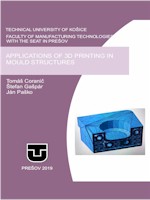|
 |
Introduction
Additive manufacturing frequently referred to as 3D printing is defined by ISO TC 261 standard as a process of adding layer-upon-layer of material with the use of data of the 3D model created in CAD system to manufacture final component parts by means of which it differs from subtractive and formative manufacturing.
At present additive manufacturing covers a number of machines differing by the applied manufacturing technology, means of added material and sphere of utilization. The main advantage of use of additive manufacturing is unquestionably a variance of structure de-sign being incomparable with the use of other manufacturing methods. It offers opportuni-ties especially in development and consequently in manufacturing of prototypes, in testing of functional samples, in utilization of modern alternatives of modelling and manufacturing of complicated geometries and structures, in reduction of weight, etc.
However, on the other hand, certain obstacles do exist in case of use of technologies of additive manufacturing such as high acquisition costs related to machines and material, slow manufacturing, insufficient quality and accuracy connected to inevitability of further machining. On the basis of rapid development of these technologies during last decades it can be assumed that some of the factors shall be eliminated in the near future. Reduction of machine and material costs and increase of manufacturing pace is expected. Regardless of the obstacles, the technologies are nowadays being used in the industrial practice. Follow-ing the aforementioned it is clear that the technologies are viable with particular specific applications even at present.
Unquestionably, one of the applications includes utilization in case of mould manufactur-ing. The main advantage brought into process of structure of moulds by additive manufac-turing stems in so-called conformal cooling systems of moulds. Contrary to conventionally drilled cooling systems the conformal cooling offers more flowing distribution of tempera-ture in the mould cavity resulting in reduction of annealing stress in a cast or in a moulded piece which is also connected with overall time of manufacturing cycle as no additive cool-ing in the mould cavity is needed and the final product can be thus moulded more quickly. However, the DMLS technology involves also certain difficulties in the manufacturing process. One of the serious problems refers to occurrence of annealing stress in the course of the manufacturing. Action of the annealing stress especially in marginal areas of the model causes clinks and cracks which in better case lead to inaccuracy of a final product. The worse is the case in which the selected component gets completely detached from the machine platform resulting in its damaging and possible collision between the component and moving parts of the manufacturing equipment.
Shiomi et al. [2004] ranks among the first to have dealt with the issue of annealing stress with examination of the stress in case of selective laser sintering of chrome steel AISI 4140. On the basis of results it was concluded that to certain extent annealing stress can be reduced when the base plate is preheated. Merselis et al. [2006] took a different path and studied the influence of orientation of the laser move. The findings proved that the anneal-ing stress was higher in case of samples manufactured by laser performing cyclic move in a single direction contrary to samples with changing laser trajectory direction. Leuders et al. [2013] studied resistance to formation of cracks due to annealing stress and on the basis of their results it can be assumed that annealing stress is accumulated in the marginal positions of the manufactured model and is considerably higher in the direction of manufacturing than in the direction perpendicular to this direction. Vrancken et al. [2014] examined the influence of orientation of the model upon occurrence of annealing stress. The results proved that the annealing stress represented the main factor in case of anisotropic behav-iour of material of the component manufactured by the DMLS technology. The issue of occurrence and reduction of annealing stress remains unsolved and right that was the moti-vation to elaborate the monograph with the attention focused on areas of formation of an-nealing stress and its amplitudes. The practical part presents a proposal of alternative solu-tions involving optimization of inner structures with regards to preservation of functionality and service life of the manufactured component which was shaping intermediate piece de-signed for plastic injection. Other benefits of these alternative solutions include reduction of manufacturing time and material saving which eventually decreases the production costs and increases competitiveness of the company.
